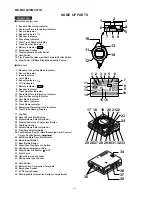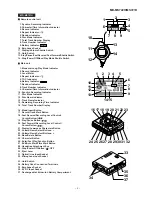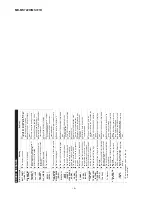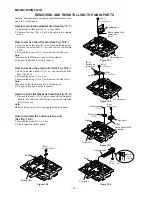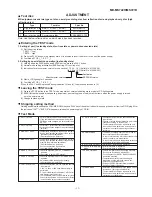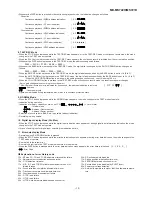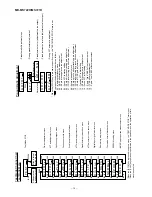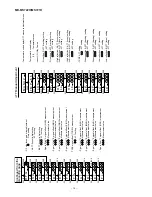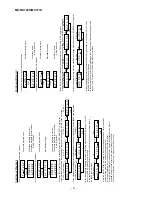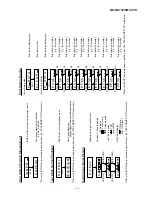
MD-MS722H/MS721H
– 7 –
Moisture condensation
In the following cases, condensation
may form inside the unit.
Shortly after turning on a heater.
When the unit is placed in a room
where there is excessive steam or
moisture.
When the unit is moved from a cool
place to a warm place.
When the unit has condensation inside,
the disc signals cannot be read, and the
unit may not function properly.
If this happens, remove the disc.
The condensation should evaporate in
approximately 1 hour. The unit will then
function properly.
TROUBLESHOOTING
If
t
ro
ubl
e occ
ur
s
When this product is subjected to strong
external interference (mechanical shock,
excessive static electricity, abnormal sup-
ply voltage due to lightning, etc.) or if it is
operated incorrectly, it may malfunction. If
such a problem occurs, do the following:
1.
Unplug the AC adaptor from the AC
socket.
2.
Remove the battery.
3.
Leave the unit completely unpowered
for approximately 30 seconds.
4.
Plug the AC adaptor back into the AC
socket and retry the operation.
If strange sounds, smell or smoke come
out of the unit or an object is dropped into
the unit, remove the AC adaptor from the
AC socket immediately and contact an au-
thorised SHARP service centre.
Many potential “problems” can be resolved by the owner without calling a service tech-
nician. If something seems to be wrong with this product, check the following before
calling your authorised SHARP dealer or service centre.
PROBLEM
CAUSE
The unit does not turn
on.
Is the AC adaptor disconnected?
Is the battery exhausted?
Is the unit in the safety mode?
Has condensation formed inside the unit?
Is the unit being influenced by mechanical shock or by
static electricity?
No sound is heard
from the earphones.
Is the volume set too low?
Is the remote control unit or the earphones plugged
in?
Are you trying to play a MiniDisc with data on it
instead of a MiniDisc containing music?
When the operation
buttons are pressed,
the unit does not
respond.
Is the unit in the safety mode?
Is the battery exhausted?
Is the remote control unit plug or the earphone plug
inserted firmly?
Some sounds are
skipped.
Is the battery exhausted?
Is the unit being subjected to excessive vibration?
The MiniDisc cannot
be ejected.
Has the track number or character information been
written on the disc yet?
Is the unit in the recording or editing mode?
Recording and editing
are impossible.
Is the MiniDisc protected against accidental erasure?
Is the unit connected properly to the other equipment?
Is the AC adaptor unplugged or did a power failure
occur whilst recording or editing?
Is the unit in the safety mode?
Is an optical signal being output from the external
equipment?
Read the operation manual for the external equipment.
Even if the maximum recording
time of a MiniDisc has not been
reached, “DISC FULL” or “TOC
FULL” may be displayed.
When the number of tracks used
reaches the limit, regardless of the
remaining recording time, further
recording will be impossible.
(Maximum number of tracks: 254)
If a MiniDisc has been recorded or
edited repeatedly or if a MiniDisc has
scratches on it, it may not be possible
to record the maximum number of
tracks on it.
Even if the number of tracks and
the recording time have not
reached the limit, “DISC FULL” may
be displayed.
If there are scratches on a disc, the
unit will automatically avoid recording
in those areas. The recording time will
be reduced.
Even if several short tracks are
erased, the remaining recording
time may not show an increase.
When the remaining recording time of
a disc is displayed, short tracks less
than 12 seconds long may not be
included in the total.
Two tracks may not be combined in
editing.
For MiniDiscs on which repeated
recording and editing operations were
performed, the COMBINE function
may not work.
The total of the recorded time and
time remaining on a disc may not
add up to the maximum possible
recording time.
A cluster (about 2 seconds) is
normally the minimum unit of
recording. So, even if a track is less
than 2 seconds long, it will use about
2 seconds of space on the disc.
Therefore, the time actually available
for recording may be less than the
remaining time displayed.
If there are scratches on discs, those
sections will be automatically avoided
(no recording will be placed in those
sections). Therefore, the recording
time will be reduced.
When recorded tracks are played
back using the cue and review
operations, some sounds may be
skipped.
For MiniDiscs on which repeated
recording and editing were performed,
some sounds may be skipped whilst
cueing and reviewing.
A track number can be created in
the middle of a track.
If there are scratches or dust on a
MiniDisc, the track numbers following
that track will be increased by one.
MiniDiscs are recorded using a different system than is used for cassette tapes or DAT
recordings. Therefore, the following conditions may be encountered, depending on how
the disc has been recorded or edited. These are due to system limitations, and should
be considered normal.
MINIDISC SYSTEM LIMITATIONS



